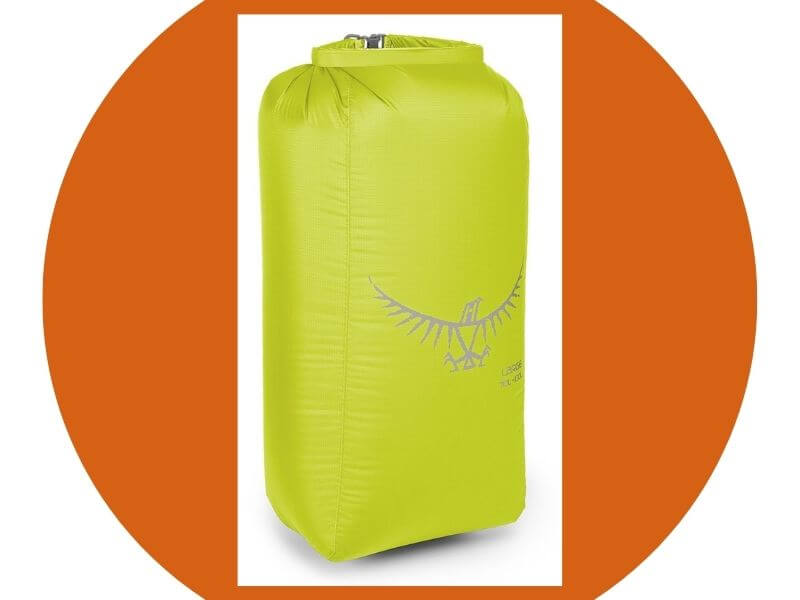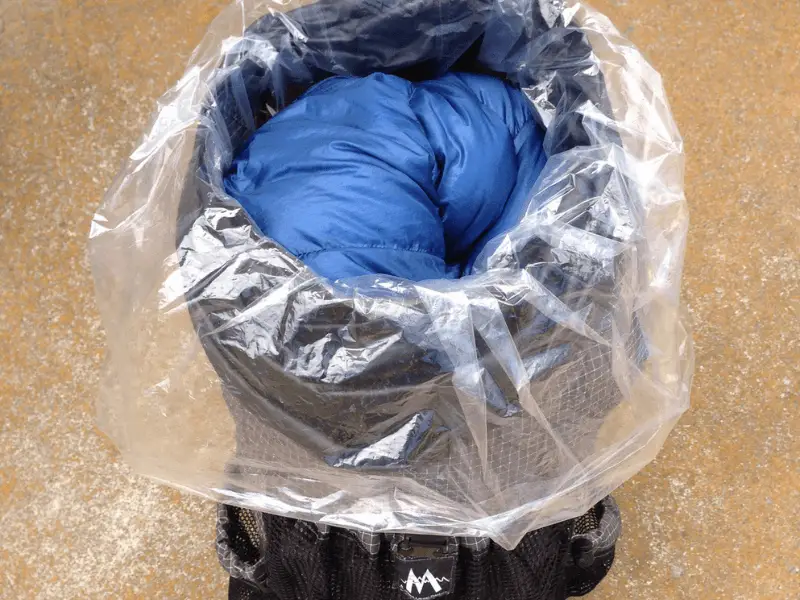The last thing you want to deal with after a long day of hiking in wet gear. Backpacks can not protect your gear from rainy situations. That is why pack liners and dry bags come in handy. So the question is which outweighs the other in terms of pros and cons.
Dry bags are bags that keep your luggage dry during the rainy season or storms. They are waterproof and provide an extra layer of protection for the most crucial items in your backpack. Pack liners on the other hand are used on the inside of the backpack.
It all comes down to an individual’s preference of what they want to keep dry, how much weight they are trying to save, and how long they will be on the road. Here, we will look at the differences between the pack liners and dry bags as well as when to use each of them.

Pack liner vs dry bags – Key differences
When it comes to protecting your gear from rain, both the pack liner and dry backs have their strengths and weaknesses. Here are the key differences between both.
| Pack liners | Dry bags |
| Susceptible to wear and tear | Very hardy, tough, and do not get perforated easily. |
| Used inside the backpacks so does not protect the exterior of it. | Protects everything in the backpack and the exterior of the backpack. |
| Suitable only for contents inside a backpack | Suitable for both backpack gear as well as sleeping bags and electronics |
| They are not efficient for people engaging in water-based sports | Suitable for both swimmers and hikers. |
| They are relatively cheap compared to dry bags. | Quite expensive |
| Do not add any weight to the backpack | They add extra weight to your backpack |
Pack liners
They are typically made of lightweight coated nylon or ultralight silnylon and include an elastic string that tightens around the pack to hold it in place. A cover protects the majority of your luggage from the elements as well as items attached to the outside.
See related: Silpoly vs Silnylon
Pack liners, on the other hand, have faults. For example, they do not totally protect the area around your shoulder straps and hip belts. The area above and around your shoulders is particularly delicate.
During a rainy day, water will usually find its way in. Despite being significantly more durable than garbage bags, pack covers can nevertheless catch and rip on twigs and branches in thickly forested places.
There are made in various sizes. Choose one that is just big enough for you for a snug fit and the right material for maximum protection.
Dry bags
They are sturdy, dependable bags made of durable waterproof fibers that can safeguard everything submerged in water. They feel like a waterproof jacket or in other varieties like plastic.
The roll-top is normally very rigid to keep the water out, and there is always a buckle on either side of the lid to click together after you’ve wrapped it up. During any adventure, the elements from your electronics to your other gear will be protected
Dry bags allow you to keep your food and drink totally water-free, allowing you to extend your excursion in a safer manner. Even in the heaviest of rains, your food will remain dry and food that is dry is edible.
Nobody wants wet garments from a leak that could have been avoided. Worse, your clothing or equipment may get soaked and become entirely wet. The dry bags ensure that your clothes do not get water on them. There is nothing like coming from a long hiking excursion and changing into dry comfortable clothes.
Dry bags are also used to store sleeping bags. Most dry backs or compressor sacks are not only waterproof, but they also compress your sleeping bag, clothes, towels, and other items to around half their original size.
It may add some weight to your bag, but because your gear is compressed, you can get by with a much smaller backpack.
When to use a pack liner
Ideally, you should consider using a pack liner when going for a long hike. Pack liners are less prone to tears, and if they do, duct tape can be used to fix them.
One of the features that distinguish and add value to a waterproof pack liner is its volume. It can hold whatever you have in your other stuff sacks and more. In an emergency, it is usually large enough to give refuge or basic clothing.
There is no way to compensate for it with other stuff sacks or equipment in your backpack because nothing else comes close to matching its versatility.
Recommended pack liner option
Here are two of the best pack liners in the industry:
Clear Pack Liners by Gossamer Gear (48.5L)
Gossamer Gear makes extremely tough, transparent pack liners. They are lighter than trash compactor bags, weighing only 1.2 ounces, and are easier to repair if a hole is punched in one.
They are open at the top, so you must fold them over or twist-tie them to keep your items dry, but they work. They are also fairly priced. They inherit the inside color of your pack but have no effect on making your belongings easier to find.
Liner Bags for Nylofume Packs (51.9L)
The 0.91-ounce Nylofume Pack Liner Bags are little plastic bags that are extremely durable. They have a volume of 51.9 liters, which is plenty for most of the packs used on a regular basis, plus extra space for folding over the top to keep moisture from above out.
They are also odor-resistant and can be quickly repaired with packing tape, making them appropriate for use as food bag liners.

When to use dry bag
Dry bags are mostly used when you do not want anything, from the exterior of your backpack to the interior, to get wet. They are also suitable for areas where it is very rainy or water-based sports. Dry bags ensure your phone, clothes, sleeping bag and even the whole backpack stay dry.
They are quite hardy so very recommended for people engaging in vigorous activities such as excursions involving trekking in water bodies. Even when submerged in water, the dry bag stays completely dry.
They are not prone to tears so one does not have to worry about not packing sharp objects. They are however not suitable for short hikes, for example, a one-day hike. This is because they are quite heavy and not very fun to carry for ultra-light backpackers.
Recommended dry bag option
Ortlieb PD350 Dry Bag
They are thick, chunky dry bags that are intended to be thrown in water. If you’re going kayaking or need to be confident your gear will stay dry, this is the best dry bag. Sizes range from 13 to 79 liters. That is plenty of room to fit most backpacks.

Exped Fold Dry Bag Five-Piece
If you need a range of sizes all at once, Exped’s multi-pack is an excellent place to start. Depending on the size you want, they come in packs of four or five. They are strong and long-lasting. They are suitable for hiking but would not withstand water-oriented activities.

Set Sea to Summit Hydraulic Dry Pack
It’s a bit of a specialized piece of gear: it’s waterproof and incredibly easy to transport thanks to built-in rucksack straps. Consider this if you need to transport a lot of heavy equipment a long distance within a dry bag.

Conclusion
Dry bags are more suitable for both hiking and water-based excursions. They protect everything inside the backpack and the exterior of it. However, in terms of price and weight, one might consider going for pack liners.
Sources
https://www.youtu.be/zVKmAK3SqzA
https://www.youtu.be/vFushA_y6hU
